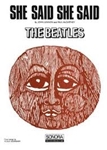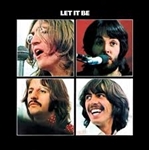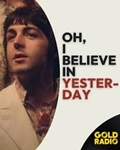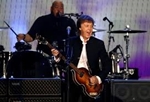- Register
- Log in to Tune-In
- Wishlist (0)
-
Shopping cart
(0)
You have no items in your shopping cart.
Beatles News

It's been nine years since the tragic demise of music producer George Martin, best known for his groundbreaking work with The Beatles. Those included Paul McCartney, John Lennon, George Harrison, and Ringo Starr. Martin worked so closely with the famed British band that he was frequently nicknamed the "fifth Beatle." He died of undisclosed causes on March 8, 2016. Martin was 90 years old, and this is his story.
George Martin was born on January 3, 1926, in Highbury, United Kingdom.
From Please Please Me, the Beatles' initial collected work (released in 1963) to their Abbey Road album (released in 1969), Martin worked diligently with the so-called 'Fab Four' to perfect the unique sound and elements of each of their compositions.
Following the band's dissolution, Martin produced for Paul McCartney and Ringo Starr on their solo albums, specifically McCartney's James Bond movie track release Live and Let Die (1973).
Martin also worked closely with additional music icons such as Kenny Rogers, Celine Dion, Elton John, and more.
On March 8, 2016, Martin passed away quietly in his sleep.
Source: Herbie J Pilato/newsbreak.com
details
George Harrison was a stoic and quiet individual. He had no shortage of talent both in The Beatles and as a solo artist, and the latter of which was (in my opinion) where he truly shone. He wasn’t the big smack-talker, either. But George Harrison did have a few choice words for some of his musician contemporaries, and even disliked a few famous bands and musicians. Let’s look at a few examples, shall we?
Oasis
I’ll be honest, I was surprised to see this band mentioned in my research for this list of musicians that George Harrison famously disliked. Oasis? Really? A lot of people had some choice words for the Britpop band back in the day, but I wouldn’t have thought George Harrison, formerly of The Beatles, would be paying attention to them, specifically.
Well, it appears that this one is true, and George Harrison was not a big fan of Oasis in the 1990s. In fact, in 1996, Harrison pretty directly said that their music “lacks depth” and that “singer Liam [Gallagher] is a pain, the rest of the band don’t need him.” Ouch. No wonder Gallagher threatened to punch him.
Sex Pistols
The Beatles, in a roundabout way, were pretty punk rock for th details

James Norton to Play Beatles Manager Brian Epstein in Sam Mendes’ Groundbreaking Biopic Series
Happy Valley actor James Norton is reportedly stepping into the shoes of the man behind the Beatles’ meteoric rise: Brian Epstein. The casting, yet to be officially confirmed, is for Sam Mendes’ unprecedented four-film biopic series chronicling the lives of the Fab Four.
Norton would portray Epstein, the shrewd and stylish manager who discovered the Beatles in a Liverpool basement club in 1961 and guided them to global superstardom before his tragic death in 1967. His role is pivotal to the Beatles’ origin story — and the films are aiming for just that: the full picture.
Announced in 2024, Mendes’ project will present four interwoven narratives, each from the perspective of a different Beatle. It marks a historic moment in music cinema, as Apple Corps has for the first time granted full life story and music rights for such a project.
Slated for a 2028 release, the biopics will star a dynamic ensemble:
Paul Mescal as Paul McCartney
Harris Dickinson as John Lennon
Barry Keoghan as Ringo Starr
Joseph Quinn as George Harrison
The behin details

When Carole King made the rounds introducing herself to all four of The Beatles at a party at the Warwick Hotel in New York City, the songwriter came face to face with each musician’s unique personalities (and reputations): Paul McCartney was affable and chatty, George Harrison was quiet but polite, Ringo Starr “was Ringo,” and John Lennon was snarky to the point of being downright rude.
At the time, King didn’t press Lennon to see if his behavior was actually directed toward her or if she was an unfortunate but unintentional victim of one of his sulkier moods. She was hardly a nobody at the party, after all. Even McCartney stopped to tell her what a great influence she and her songwriting partner, Gerry Goffin, were to him. But at 23 years old, getting blown off by one of the biggest rockstars in the world was going to sting, no matter how many hits she had under her belt.
During a 2012 interview at the John F. Kennedy Presidential Library and Museum, King described the memorable moment. Lennon was the last Beatle she had to introduce herself to. “He’s standing with two women, neither of whom was Cynthia [Lennon, his first wife]. He looks high; he looks like he’s totall details

For some people, an album is simply a collection of singles and a few fillers and nothing more. Paul McCartney, however, is an artist who typically considers his work more carefully. He and the Beatles helped define the modern album—work that seems to expand the bounds of what an album was in the decades before their rise to fame. Because of this, McCartney fans were shocked when he made an album full of what he called “throwaways.” Find out which album that was below.
McCartney’s writing always stood in stark contrast to his bandmates’. By the end of their tenure, the band had all but given up on McCartney’s whimsical songwriting voice. To pursue that creative ambition, he needed to shed the weight of the other Beatles.
Though he got his wish, it wasn’t as easy a road as he might have thought before the band broke up. Of course, changing gears might have seemed like heaven to McCartney in the middle of the Beatles’ tenuous relationship, but finding solo success was almost equally as hard.
Fans wanted more of the same, which they couldn’t have after the Beatles parted ways. In hindsight, it would’ve been impossible to please everyone with a debu details

There has never been a band comparable to the Beatles, so it stands to reason that capturing their music-altering run as a film would require an approach just as unprecedented.
That seems to be the logic behind Sony Pictures' The Beatles — A Four-Film Cinematic Event, the collection of biopics — each told from the perspective of an individual band member — officially unveiled at CinemaCon earlier this year.
The four interconnected films are currently casting up ahead of production and a planned 2028 release. In the meantime, here's everything you need to know about the ambitious project.
Who is playing the Beatles in the movies?
Sony understandably made a spectacle of their casting announcement, revealing the four leads for the "Cinematic Event" at CinemaCon, all of whom are actors on the rise from the British Isles.
Oscar nominee Paul Mescal will play Paul McCartney. Babygirl breakout Harris Dickinson will be John Lennon. The Banshees of Inisherin Best Supporting Actor nominee Barry Keoghan will play Ringo Starr. Stranger Things and The Fantastic Four: First Steps actor Joseph Quinn will be George Harrison. Who else has been cast?
Casting outside of the details

An “impractical” song written before She Said, She Said is the first psychedelic song John Lennon ever wrote.
The Beatles member behind hits like Come Together and I Am the Walrus confirmed an earlier song was actually his first test of psychedelic-tinged songwriting. Lennon would confirm this two years after The Beatles had officially split up, giving an interview breaking down his writing style in the early years. Though the song proved “impractical” compared to the popular She Said, She Said, it would be the first time Lennon had written with a psychedelic intention in mind. A few candid reflections on the song in question were shared in 1972, where Lennon wished he had stuck to the “original idea” he had for Tomorrow Never Knows, a song which featured on Revolver.
He said: “This was my first psychedelic song. Tomorrow Never Knows… I didn’t know what I was saying, and you just find out later. I know that when there are some lyrics I dig, I know that somewhere people will be looking at them.
“Often the backing I think of early-on never comes off. With ‘Tomorrow Never Knows’ I’d imagined in my head that in the background you details

Had he lived, Lennon would have celebrated his 85th birthday on October 9, 2025. Here are five songs written by John Lennon but recorded by other acts.
John Lennon’s body of work is staggeringly impressive. With The Beatles and as a solo artist, he created some of the most enduring music of the rock era. And though it represented a small fraction of his creative output, his work as a writer for (and in one case, with) other artists is worthy of note. In addition to his production credits (for wife Yoko Ono, The Silkie, David Peel and the Lower East Side, Mick Jagger and Harry Nilsson), Lennon composed songs expressly for other artists he admired. Nearly all of that activity took place between his leaving The Beatles in 1969 and the start of his retirement/hiatus in 1975. Had he lived, Lennon would have celebrated his 85th birthday on October 9. On the occasion of the 50th anniversary of the first of many compilations surveying his solo work – 1975’s Shaved Fish – here are five songs written by John Lennon but recorded by other acts.
“God Save Us” by Bill Elliot & the Elastic Oz Band (single, 1971)
In the years immediately following The Beatles’ breakup, Lenno details

The Beatles had wanted to put on a final performance before they split up.
Though Paul McCartney, John Lennon, George Harrison, and Ringo Starr would play out a show on the roof of Abbey Corps Headquarters, the four had spoken of playing a regular, attended show. Lennon would say it’s the reason he had agreed to a television special, which had been scrapped during the making of the band’s final two albums. Harrison would also say he “really wanted to play” but that the opportunity to do so had simply not occurred during their sessions together. McCartney would also suggest a live show was the right time to “light a rocket and really take off for the end” of the band. Plans for a show beyond the rooftop gig never came to be, though it seemed the band were keen on performing together in front of a planned, ticketed audience.
Lennon would say during the Get Back sessions in 1969 that he would have liked to play live with The Beatles again. He said: “I would dig to play onstage, you know? I mean, if it was all… everything was all right and there was no messing and we’re just gonna play onstage.
“You know, that’s why I said yes to the TV show. details

English actor James Norton will play Brian Epstein, the influential manager of the Beatles, in the upcoming four-part musical biopic by director Sam Mendes.
He’ll star in “The Beatles — A Four-Film Cinematic Event,” as the unconventional project has been dubbed, alongside Paul Mescal as Paul McCartney, Harrison Dickinson as John Lennon and Barry Keoghan as Ringo Starr and Joseph Quinn as George Harrison.
Epstein, a legend among Beatles fans and often considered the band’s fifth member, met the Fab Four in 1961 and helped propel them into a global phenomenon. He was with the group until he died in 1967 from a drug overdose at age 32. (Epstein’s own epic story was immortalized in the 2024 biopic “Midas Man.”)
Sony, the studio behind the films, declined to comment on Norton’s casting, which was first reported by Deadline.
Mendes is making four separate movies, one from each Beatles member’s point of view. All four installments will debut on the big screen in April 2028. The films are expected to intersect to capture the band’s improbable journey from Liverpool to the center of global culture, leading to their 1970 breakup. Given details

The story of how one of The Beatles' biggest ever songs was almost not released under the band's name.
The Beatles were always so much more than the sum of their parts. Despite the delights of John Lennon and Paul McCartney's solo careers (and those of George Harrison and Ringo Starr, too), when the Fab Four were together they genuinely changed the history of popular music and the whole society.
But even when they were together there were moments when individual members of the band were in complete creative control.
That was especially true on The Beatles (aka The White Album), when each corner of the band was frequently off doing their own thing. But there's one much earlier example that really stands out, too. 'Yesterday' is one of the most famous Beatles song that very nearly wasn't a Beatles song. This is why.
Who wrote 'Yesterday'?
Like the vast majority of The Beatles' original songs, 'Yesterday' was credited to Lennon–McCartney. It says it right there on the label.
But we all know that while some of the duo's songs for the Fab Four were true co-writes and many were driven by one of the pair and polished by the other, there were songs that were prett details

Saoirse Ronan is set to play photographer and musician Linda McCartney in the upcoming Beatles biopic.
The Oscar nominated actress will play alongside Paul Mescal, who takes up the role in the four films, directed by Sam Mendes.
The films are set for simultaneous release, with each film focusing on one of the four band members. Saoirse Ronan is set to play photographer and musician Linda McCartney in the upcoming Beatles biopic.
Linda married Paul in 1969, with the pair going on to have three children together. Born and raised in New York City, Linda was the second of four children to Louise and Lee Eastman. Linda attended Scarsdale High School and then Vermont College, where she obtained an Associate of Arts in 1961.
She majored in Fine Arts at the University of Arizona, where she also developed a fondness for photography. Linda didn’t complete her studies due to the tragic death of her mother in a plane crash in 1962. Linda got her start in photography when she took up a receptionist and editorial assistant gig with Town & Country magazine.
Before Paul, Linda was married to Joseph Melville See Jr. They married in 1962 and divorced t details

Jack Walters is a film and television journalist based in Newcastle, UK. He is a Senior Writer on Screen Rant's New Movies team, and has also published work at Loud & Clear Reviews, Next Best Picture, and ScreenSphere.
Another important casting announcement was recently unveiled for Sam Mendes' four Beatles biopics. Saoirse Ronan will officially play Linda McCartney in the four-movie cinematic event, while Anna Sawai, Aimee Lou Wood, and Mia McKenna-Bruce are reportedly circling the roles of Yoko Ono, Pattie Boyd, and Maureen Starkey, respectively.
Mendes' Beatles films will be released simultaneously in April 2028, with each movie detailing the Beatles' story from a different band member's perspective. This will be a very interesting step forward for the biopic genre, and it crucially means that certain characters will appear multiple times across the movies - so it's even more important that they're accurately cast.
8. Cynthia Lennon - Depending on which era of the Beatles' career these movies take place throughout, Cynthia Lennon will need to be present to some degree. Even if Sam Mendes decides to set his stories after John and Cynthia's breakup, there's no way to write her out of the
details

Before he was known as a writer, producer and one of the world’s foremost fingerstyle guitarists, Laurence Juber spent three years, from 1978 to 1981, as a member of Wings. Prior to that, he had established himself as an in-demand London session guitarist. An invitation to jam with Wings guitarist-bassist Denny Laine soon changed into a life-changing event when Paul and Linda McCartney joined in.
After playing a few blues and reggae tunes, Paul turned to Juber and asked, “What are you doing for the next few years?”
“It was in that nanosecond that everything flashes in front of you,” Juber says. “I had spent my entire teenage years and beyond becoming a studio musician, and then there's Paul McCartney offering me a gig.
“On the one hand, you think, What am I giving up? On the other hand, I was in a place in my life where, if there was going to be a big change, the universe was kind of leading me to it. How could I say no?”
Juber contributed guitar parts to the 1979 Wings album, Back to the Egg — his fire-spitting solo on the punk-rockabilly number “Spin It On” is a particular standout — and he played with Wings on their 19-dat details

Paul McCartney will release "McCartney III" in December, a new collection of stripped-back songs all written, performed and produced by the ex-Beatle, 50 years after his first solo album.
Recorded this year in Sussex in southern England, McCartney III is mostly built from McCartney's live takes on vocals and guitar or piano, overlaying his bass playing and drumming.
It joins two other albums - McCartney and McCartney II - created single-handedly by the 78-year-old at critical times in his life, in 1970 and 1980, when he was seeking a creative rebirth.
"I was living lockdown life on my farm with my family and I would go to my studio every day. I had to do a little bit of work on some film music and that turned into the opening track and then when it was done I thought what will I do next?" said McCartney.
He turned to half-finished fragments he'd created over the years. "Each day I'd start recording with the instrument I wrote the song on and then gradually layer it all up, it was a lot of fun. It was about making music for yourself rather than making music that has to do a job. So, I just did stuff I fancied doing. I had no idea this would end up as an album."
McCartney's details
